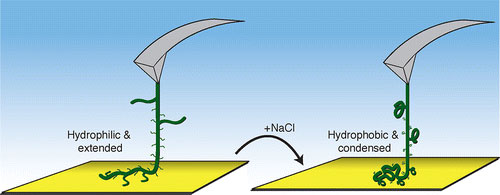| Jan 15, 2013 |
Researchers demonstrate concept of 'intelligent' molecule
|
|
(Nanowerk News) Intelligence is not only a matter of humans and animals. Scientists speak also of intelligent molecules. The latter directly react to external stimuli and change reversibly their shape. NIM physicists demonstrate the process for the first time with a single molecule.
|
|
Intelligent molecules could work in the future as nanoswitches: stimuli such as hot-cold, light-dark or altered salt concentrations can be toggled/switched back and forth between different conformations and thus act by itself as stimulus generator. Molecules with these abilities can be found in different groups of elements, but especially in proteins and synthetic polymers.
|
 |
| The new results demonstrate at the single-molecule level how solvent-induced collapse of an environmentally responsive copolymer modulates surface adhesion forces and bridging length distributions in a controllable way.
|
|
Until the real use of intelligent molecules, science must still learn about these compounds. The LMU physicists Dr. Michael Nash from the group of Prof. Hermann Gaub, a member of The Cluster of Excellence Nanosystems Initiative Munich (NIM), has now succeeded in making a reaction with a single polymer molecule visible for the first time ("Single-Molecule Adhesion of a Stimuli-Responsive Oligo(ethylene glycol) Copolymer to Gold"). For this, Nash and his colleagues placed a self made synthesized polymer on a gold surface using an atomic force microscope (AFM). One polymer end adhered on the surface and the other end at the tip of the AFM. Once the scientists increased the salt concentration of the surrounding medium, they were able to observe how the molecule collapsed gradually.
|
|
"In a highly concentrated salt solution, the polymer compound dehydrates and shrinks," says Dr. Michael Nash, first author of the study. "Back in a weak salt solution, the molecule unfolds again. We have observed both processes in our study for the first time for a single polymer molecule”
|
|
The new method of the biophysicists from Munich provides an important element for nanoswitches of the future and their potential use in biosensors, drugs, chromatography procedures and much more.
|

